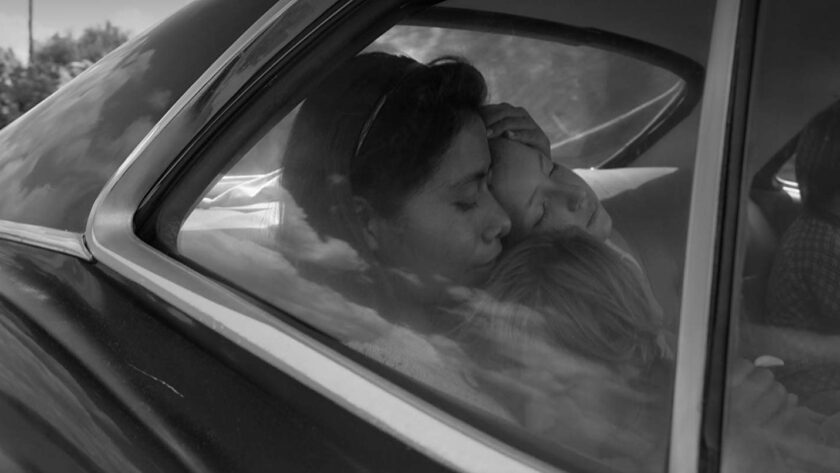It’s festival season! The FilmSoc blog is covering the 75th Venice International Film Festival (29 August – 8 September), diving into the myriad of films and events on offer to deliver reviews.
Milo Garner analyses Alfonso Cuarón’s personal introspection of his hometown, Mexico City.
Set in a district of Mexico City sharing the same name, ROMA is not the first film to bear such a title. In 1972, Federico Fellini released his own Roma, a series of semi-autobiographical vignettes that captured the Italian capital as he understood it. These varied from a symphony of traffic jams to a lewd display of religion-as-carburet – the ultimate aim was to create a kind of a cross-section of society as according to Fellini’s mind. Alfonso Cuarón’s film does not reflect Fellini’s at first blush, even seeming to be its opposite. It is set around a single family, is largely focused on genuine realism, and is limited within the confines of a single year. Yet it is in watching it unfold that a certain similitude becomes newly apparent. Cuarón is not simply using Mexico City and its environs as a setting, but rather as an essential part of the narrative. Every long traversal shot, or incidental detail, or lengthy tangent – these are not elements of pacing or plot so much as an attempt to recreate Mexico City of the early 70s, breathing and alive. Though we recognise the characters in them, these are, in effect, vignettes just as in Fellini’s film. Little moments that form the time and the place; this family does not exist in a drama extraneous to its surroundings, but one very much part of it.

An example might be a scene in which Cleo (Yalitza Aparicio) goes to the cinema with her boyfriend. The frame is filled with detail: a man selling bouncing balls outside the door, the subtle change from an indigenous language to Spanish on the arrival of Cleo’s beau, and an extended scene from an old British war film, just a little out of focus and subtitled in Spanish. Cuarón is recreating the world of his childhood, permitting a sense for atmosphere that might otherwise be inimitable. Orson Welles once said of ‘the great supercutter’ Ernest J. Nims that he “believed that nothing should be in a movie that did not advance the story.” Welles went on to lament that “since most of the good stuff in my movies doesn’t advance the story at all, you can imagine what a nemesis he was to me.” So too would Nims find a foe in Cuarón, I think – it is between the beats that ROMA finds its heart; an endearing portrait of a past remembered. Not always a beautiful or pleasant past, but one that feels genuine; and lived in.

Against this lively backdrop plays out a largely straightforward narrative, but one that is just as emotionally accomplished. It is best surmised through reference to another film, one featured briefly in ROMA (and presumably figuring significantly in Cuarón’s youth): Marooned. The few seconds of footage presented are of two astronauts lost in space, comparisons to Gravity seem obvious. But more relevant is its reflection of ROMA, in which we find Cleo in a situation aptly described by that titular verb. She is indigenous and yet appears an outsider – the children she minds ask why she speaks in a language they don’t understand. She loses her virginity to a man who promptly up sticks when she reveals the baby she’s unwillingly carrying. The closest to family we can decipher are her employers. They are all happy together, but there is an inescapable distance separating them. That she is an employee always threatens to undo any sense of belonging, and thus she watches from the exterior. Cuarón understands the socio-political nature of this character but decides against didacticism, instead preferring a subtlety. Just hints at the wider picture, caught in the back of frame, or in a brief exchange. Most disruptive is a student protest that breaks into violence, but even this is treated as a passing event rather than a subject for comment or analysis. Cuarón’s Mexico is not an academic representation, but a snapshot. In one scene a wedding is taking place just out of focus – the end to another film perhaps, but nothing to do with this one. A world that breathes beyond the camera’s end.

Supporting this flowing and often moving story is Cuarón’s typically excellent formal ability. His style is consistent with his earlier works in that it emphasises long takes and conjoined scenes, but is also more specifically adapted for this project. His use of long traversals to capture the streets of Mexico City are almost tableaux, encompassing details without lingering. He also makes use of extended panning shots, exploring the family home with its corners and crevices. This is again an understanding of space and its importance – the home acts as a location, but also a tactile part of the characters’ lives. This is just as true on the rooftop, where an extended shot captures the various maids on various other houses all washing up at once to the rumble of the city streets below. This may be the story of one family, but so many others exist on its fringes.

More specifically, metaphorical imagery is also employed, and while clearly meaningful, it is always restrained enough to avoid being forceful. One such example might be the opening shot, of a paved floor being slowly encompassed by small waves of water, then followed by soap. Wiping the slate clean, perhaps, as might Cleo desire in some way. We later find that she is the cause for this water, cleaning the driveway from the mess of the family dog. This image is granted additional effect later, with Cleo walking against the far more imposing waves of the sea, being caught in their violent crashing. Her life resembles this wading, punctuated by moments of suffering; it is her inescapable truth. A deeply moving moment. Then there is the image of the plane, a distant flyover that repeats itself throughout the film, in reflections and backdrops. A symbol of motion and progress, forward momentum, and at once distance and powerlessness. But all-encompassing, ever present.
These grander ideas exist then with those smaller, but just as impressive. A scene where Fernando Grediaga ever-so-carefully manoeuvres his oversized car into a garage several sizes too small is as funny as it is incisive, made all the more so by his wife’s later but far less graceful attempts. And it is in that comedy that ROMA finds its soul. This isn’t a tale of disaster even if disaster is often its subject. It is one that understands the downbeat as much as its opposite – the annoyance of the family dog trying to run out the gate every time it’s opened versus how funny that actually is. It is a film that encompasses so much, and yet remains deeply personal. It is the philosophy of Fellini’s film through the soulful lens of Cuarón, and the result is a wonder.
9/10
ROMA will have its UK premiere at the BFI London Film Festival on October 13, and is expected to be released on Netflix later this year. Check out its trailer below:





Thanks for putting this wonderful information. It is a film that encompasses so much.